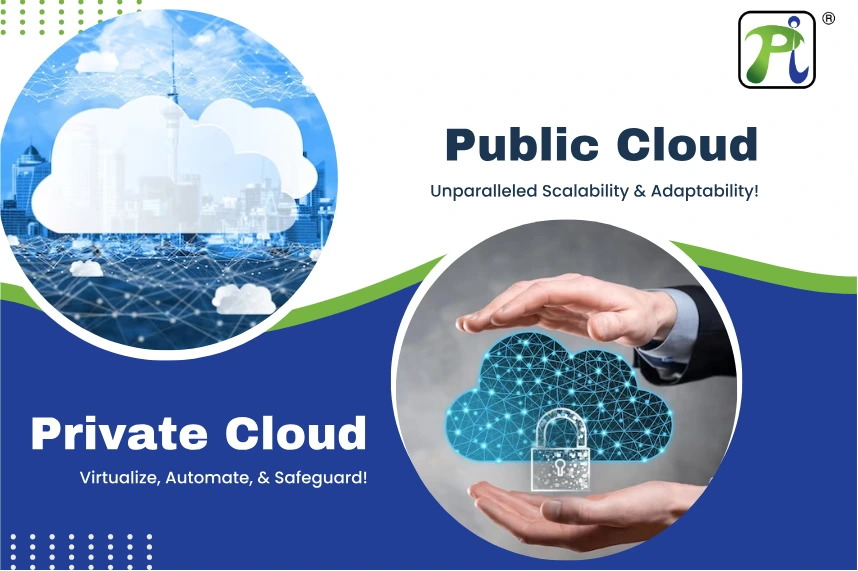We Will Get Back To You As Soon As Possible


Cloud computing has become a cornerstone in the digital transformation journey of businesses worldwide. As organizations increasingly rely on technology to drive innovation and efficiency, cloud computing offers a flexible and scalable solution for managing data and applications. Private clouds and public clouds are two distinct models that businesses can choose from based on their specific needs and requirements. While private cloud is dedicated to a single organization, providing enhanced security and control, public cloud offers shared resources hosted by a third-party provider, enabling cost savings and scalability. Understanding the definitions and differences between these two models is crucial for businesses to make informed decisions about their cloud strategy.
Let's start by building a solid foundation of knowledge about cloud computing before diving into the details of private and public clouds. Cloud computing is all about delivering computing services over the internet. These services include storage, processing power, and applications. It's a convenient and efficient way to access the resources you need.
As businesses navigate the digital landscape, two prominent models emerge: the private cloud and the public cloud. It is crucial for organizations to distinguish the differences between each option, as they all have their own distinct features, advantages, and considerations.
Why does it matter to distinguish between private and public clouds? The key lies in the customized solutions that each option provides and the significant influence these decisions can have on an organization's efficiency, safety, and ability to grow.
Private clouds, as the name suggests, are dedicated infrastructure and services exclusively for one organization. The model offers a meticulously regulated setting, typically managed either on-site or by a trusted third-party provider. When exploring further, the key elements of a private cloud encompass virtualization, automation, and strong security measures. This guarantees optimal resource utilization and maintains strict control over sensitive data.
Why do businesses opt for private clouds? The advantages span from enhanced security and compliance to increased customization and control over the infrastructure. A private cloud can be the perfect choice for organizations that have strict data regulations or specific operational requirements.
On the other side of the spectrum, public clouds offer computing services to multiple organizations over the internet. Resources are seamlessly distributed throughout an enormous network, offering unparalleled scalability and adaptability. Characterized by their pay-as-you-go model, scalability on demand, and a wide array of services, from infrastructure to software. This model is particularly attractive for startups and businesses seeking cost-effective solutions without the burden of maintaining physical infrastructure.
It offers a multitude of benefits that go beyond just being cost-effective. These features provide quick implementation, worldwide availability, and the opportunity to utilize state-of-the-art technologies without requiring substantial initial investments. They provide organizations with the freedom to prioritize innovation without the burden of managing infrastructure.
One of the primary considerations when choosing between private and public clouds is security. Private clouds offer a higher level of control and isolation, making them suitable for industries with stringent data protection requirements.
While private clouds provide control, they often come with higher upfront costs. In contrast, public clouds adhere to a pay-as-you-go framework, which empowers organizations to adjust resource allocations in accordance with their immediate requirements and financial limitations.
The level of customization and control varies significantly between the two models. Private clouds afford organizations the freedom to tailor infrastructure to specific needs, while public clouds offer standardized solutions with less flexibility but greater ease of use.
The choice between private and public clouds hinges on various factors, including data sensitivity, regulatory compliance, scalability requirements, and budget considerations. A thorough assessment of these factors is crucial for making an informed decision.
Recognizing that one size does not fit all, many organizations opt for hybrid cloud solutions—a blend of private and public clouds. This approach allows them to capitalize on the strengths of both models, creating a versatile and dynamic IT infrastructure.

Ultimately, the decision boils down to aligning cloud choices with specific business needs. The right cloud model should enhance efficiency, foster innovation, and propel the organization toward its strategic goals.
Security concerns persist in the cloud computing landscape, irrespective of the chosen model. In order to mitigate potential risks and protect sensitive data, it is critical to implement robust security measures, encryption protocols, and ongoing monitoring.
There are two sides to scalability. While public clouds inherently offer scalability, private clouds might face challenges in accommodating sudden surges in demand. Smart architecture and proactive planning are keys to addressing scalability concerns.
Navigating regulatory landscapes and ensuring compliance is critical for organizations in various industries. Cloud providers offer compliance certifications, but it's incumbent upon businesses to understand and uphold their specific regulatory obligations.
Cloud computing is on a trajectory of continuous evolution. Emerging technologies such as edge computing, serverless architectures, and advanced automation are reshaping the cloud landscape, presenting new opportunities for businesses.
Innovation within the cloud domain is relentless. From AI-driven insights to blockchain integration, the future holds exciting possibilities. Businesses that stay abreast of these innovations position themselves to thrive in the digital age.
Anticipating developments in private and public clouds involves staying attuned to technological advancements, market trends, and the evolving needs of businesses. In order to fully leverage the capabilities of cloud computing, it will be critical for organizations to prioritize continuous adaptation and strategic foresight.
Successful cloud migration starts with meticulous planning and a comprehensive assessment of existing infrastructure, applications, and data. A well-defined strategy lays the groundwork for a smooth transition.
Executing the migration plan requires precision and coordination. Continuous monitoring during the migration process is imperative to identify and address any issues promptly, ensuring minimal disruption to operations.
Post-migration, the journey doesn't end. Continuous improvement strategies, informed by performance metrics and user feedback, are essential for optimizing cloud infrastructure and maximizing its benefits.
In conclusion, the journey through private and public clouds reveals their unique attributes and applications. By recapitulating the differences, organizations can make informed decisions that align with their goals and operational requirements. Cloud computing is not a one-size-fits-all proposition. The diversity of private, public, and hybrid cloud models empowers organizations to tailor solutions that best meet their specific needs. Informed decision-making ensures that the chosen cloud strategy becomes a catalyst for growth and innovation. It's crucial to acknowledge the dynamic nature of the technology landscape. Staying agile, embracing change, and leveraging the latest advancements position organizations to thrive in an era where the cloud is not just a tool but a transformative force.
Questions? We're here to help.
©2025 Pi DATACENTERS® Pvt. Ltd. All rights reserved
